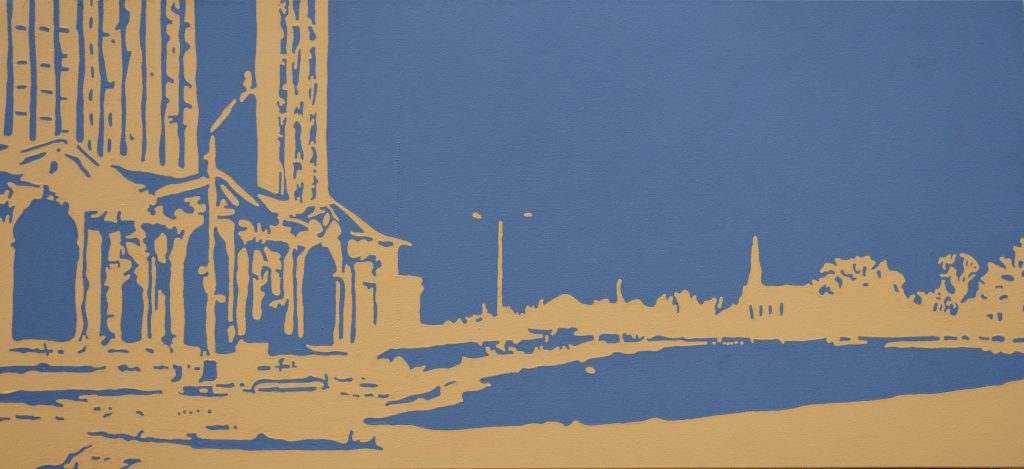When I visited Detroit around 2001, Michigan Central was completely derelict. The windows were blown out, the doors were boarded up, the roads had enormous potholes, the brownfields were crowded with weeds, and the overall sensation was one of decay. Little did I know that this impressive building would later become the subject of a painting, and that Michigan Central itself would be miraculously transformed. Though the seeds of the future can be found in the past, one can seldom discern promise and potential in ruins. This blog post tells the story behind my original painting, Detroit II, and why this contemporary artwork resonates on a deeper level.
Detroit II: A Meaningful Painting by a Hamilton-Based Artist
In 2001, I was a graduate student attending Western University in London, ON. One Saturday, I went with a fellow student to Detroit. He was interested in the city’s architecture, while I was primarily interested in its history. We took a video camera to record our impressions, and one of the stops we made landed us on the plaza in front of Michigan Central. The monumental scale of the neglect was almost incomprehensible. Presumably, this had once been a bustling, lively place. Now, it was quiet, save for the wind whipping through the barren landscape. We didn’t see a single person there. It elicited a quiet, mournful reverence and we wondered at the lack of care and stewardship of this once-beautiful building. It was decidedly anti-nostalgic, since there was little that glorified the past. While I sometimes get sentimental about heritage, the condition and scale of the ruins were cold and brutal. All the same, I did not expect then that my impression of Michigan Central would become a memory that lingered.
How the Image Came to Life

Timothy deVries, “Detroit II,” 2016. House-paint on Canvas, 24″ x 52″ inches (Artwork © Timothy deVries; photograph by Timothy deVries)
As it happened, the footage that we took in Detroit had been turned into a video by my friend, and he had dialed up the contrast and hue to make a tonal palette of only two colours. I used the same approach for my painting, finally choosing the colours of navy blue and goldenrod as complementary, contrasting colours. My sketch combined several views of the building and surrounding site, having had a conversation with another friend about the appeal of long, low artworks depicting urban scenes. He was in the process of purchasing a photograph of a street scene for the wall beside his dining table, and I thought, what a great format for a painting. As a landscape, the painting is anchored on the one side by the building, whose façade faces an open field. The broken-down feeling of my original experience is captured in the painting by jagged, irregular contours around some of building’s main features. My intent was to distill the sense of abandonment and ruin into a stark silhouette that wouldn’t be impossible to live with. Like most of my paintings, this piece was created with latex house-paint on a primed, heavy-weight cotton canvas. I think the contrast between the two colours, and the contours of the contrasting shapes, creates a clean, but striking impression. I also like how the painting combines urban elements with aspects of a natural landscape.
My Insight into the Meaning Behind Detroit II
Since my trip in 2001, I’ve never been back to Detroit. You can imagine my surprise then upon learning earlier this year that Michigan Central was restored following a six-year renovation that cost just under $1 billion. Project Architect Richard Hess, a principal at Quinn Evans, explained in an interview with Bloomberg that “I haven’t worked on another project that had such a sense of connection with people.” And no wonder, since the investments in human labour, materials and time were immense. After sitting vacant for so long, I think everyone is amazed that a benefactor had the capacity to tackle such a large project. My own connection to Michigan Central, then, doesn’t seem so strange. Detroit II marks the revival of a building against significant odds, providing significant benefits to residents of Detroit by becoming a hub for innovation and collaboration. Sometimes, success as a painter looks like being in the right place at the right time, and the serendipity to later recognize that.
Collector’s Tips
This piece is being offered for purchase at $1,065 and can be viewed by appointment in my home studio near Hamilton, Ontario. It measures 24’ x 52’ inches and comes unframed; a professionally made oak floating frame in one of various finishes can be purchased and installed at an extra cost. The painting was made in 2016 with house-paint on canvas. With its contrasting colours, urban theme, and distinct layout, this painting would look great in your dining room, great room, or open-concept space.
Beauty Can be Found in the Ruins
Detroit II connects with an experience I had almost twenty-five years ago, only to serve as a reminder that beauty can be found in the ruins. We should not let that beauty become a stumbling block in restoring from decay. This lesson has a universal application and should encourage us when we count the cost of time. As a contemporary artist in Hamilton, Ontario, I’m delighted that my painting references a story that has come full circle. If this piece resonates with you, I invite you to share your thoughts with me via email or on Instagram.
Interested in adding this piece to your collection? Contact me.
